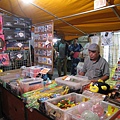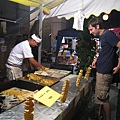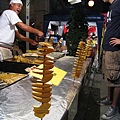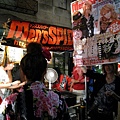上一頁下一頁

Yebisu啤酒一杯400日圓,小姐叫賣的很用力

大白買了一杯解渴,可惜沒有平常在便利商店買的罐裝Yebisu好喝

多啦A夢造型的雞蛋糕

一小袋500日圓,大袋1000日圓,味道不錯但口感稍嫌乾硬

熱愛多啦A夢的大白買了一袋雞蛋糕回家,紙袋超可愛的

滿街都是走累了席地而坐的浴衣少女

今天看到烤魚攤時又已經飽了,明年有緣再吃吧

路人小姐的示範:自己選日式剉冰的糖水口味

啊,好想回台灣吃四果冰

老伯很無奈的顧冷清的玩具攤

撈金魚這種活動還是只有小情侶做起來才浪漫啊

認真顧巧克力香蕉攤的弟弟有點柯南的味道

每年祭典我都拍很多巧克力香蕉的照片,但從來就不會想吃耶

這種馬鈴薯在台北的夜市也很常見,但我怕長痘痘沒吃過

老外對螺旋形的馬鈴薯嘖嘖稱奇,老闆用日英夾雜熱情介紹產品

賣果汁的攤位生意很好

奶油馬鈴薯也是日式祭典常見的小吃,吃一個大概就飽了吧

面具攤

這些卡通人物中我竟然只認識米妮,真慘

超大的烤扇貝

要不是已經飽了,我還真想吃啊

Men's Spider雜誌也有燒烤攤,顧店的少年個個造型誇張

回家後上網查,才知道Men's Spider是本「男公關X視覺系」雜誌

2009麻布十番納涼祭,就在視覺系少年和浴衣少女的笑容中畫下句點
上一頁下一頁
相片最新留言
-
 Justina 說:我昨天也有去...而且買的攤子...
Justina 說:我昨天也有去...而且買的攤子... -
 Care凱兒 說:Paella 西班牙海鮮飯..... 很...
Care凱兒 說:Paella 西班牙海鮮飯..... 很... -
 晴天 說:日本的撈金魚攤比較人性XD台...
晴天 說:日本的撈金魚攤比較人性XD台... -
 lunlun 說:好像台灣夜市的炒麵
lunlun 說:好像台灣夜市的炒麵 -
 凱茵斯 說:墨西哥海鮮飯
凱茵斯 說:墨西哥海鮮飯
此相簿內的相片出現在:
相簿列表資訊
- 最新上傳:
- 2009/08/25
- 全站分類:
- 國外旅遊
- 本日人氣:
- 0
- 累積人氣:
- 160692

Solving a long-standing mystery about the desert’s rock art canvas
Petroglyphs are carved in a material called rock varnish, the origins of which have been debated for years. Now, scientists argue it’s the result of bacteria and an adaptation that protects them from the desert sun’s harsh rays.
By Nathan Collins
5923141600_1bc3f25867_k.jpg
Rock art featuring human and animal forms and handprints
Petroglyphs at Mesa Verde National Park, Colorado (Christine Fry & Peter Russo)
Wander around a desert most anywhere in the world, and eventually you’ll notice dark-stained rocks, especially where the sun shines most brightly and water trickles down or dew gathers. In some spots, if you’re lucky, you might stumble upon ancient art – petroglyphs – carved into the stain. For years, however, researchers have understood more about the petroglyphs than the mysterious dark stain, called rock varnish, in which they were drawn.
In particular, science has yet to come to a conclusion about where rock varnish, which is unusually rich in manganese, comes from.
Now, scientists at the California Institute of Technology, the Department of Energy’s SLAC National Accelerator Laboratory and elsewhere think they have an answer. According to a recent paper in Proceedings of the National Academy of Sciences, rock varnish is left behind by microbial communities that use manganese to defend against the punishing desert sun.
The mystery of rock varnish is old, said Usha Lingappa, a graduate student at Caltech and the study’s lead author. “Charles Darwin wrote about it, Alexander von Humboldt wrote about it,” she said, and there is a long-standing debate about whether it has a biological or inorganic origin.
But, Lingappa said, she and her colleagues didn’t actually set out to understand where rock varnish comes from. Instead, they were interested in how microbial ecosystems in the desert interact with rock varnish. To do so, they deployed as many techniques as they could come up with: DNA sequencing, mineralogical analyses, electron microscopy, and – aided by Stanford Synchroton Radiation Lightsource (SSRL) scientist Samuel Webb – advanced X-ray spectroscopy methods that could map different kinds of manganese and other elements within samples of rock varnish.
“By combining these different perspectives, maybe we could draw a picture of this ecosystem and understand it in new ways,” Lingappa said. “That’s where we started, and then we just stumbled into this hypothesis” for rock varnish formation.
Among the team’s key observations was that, while manganese in desert dust is usually in particle form, it was deposited in more continuous layers in varnish, a fact revealed by X-ray spectroscopy methods at SSRL that can tell not only what chemical compounds make up a sample but also how they are distributed, on a microscopic scale, throughout the sample.
That same analysis showed that the kinds of manganese compounds in varnish were the result of ongoing chemical cycles, rather than being left out in the sun for millennia. That information, combined with the prevalence of bacteria called Chroococcidiopsis that use manganese to combat the oxidative effects of the harsh desert sun, led Lingappa and her team to conclude that rock varnish was left behind by those bacteria.
For his part, Webb said that he always enjoys a manganese project – “I’ve been a mangaphile for a while now” – and that this project arrived at the perfect time, given advances in X-ray spectroscopy at SSRL. Improvements in X-ray beam size allowed the researchers to get a finer-grained picture of rock varnish, he said, and other improvements ensured that they could get a good look at their samples without the risk of damaging them. “We’re always tinkering and fine-tuning things, and I think it was the right time for a project that maybe 5 or 10 years ago wouldn’t really have been feasible.”
The research was supported by the National Science Foundation, the National Institutes of Health and the National Aeronautics and Space Administration. SSRL is a DOE Office of Science user facility.
Citation: Usha F. Lingappa et al., Proceedings of the National Academy of Sciences, 22 June 2021 (10.1073/pnas.2025188118)
For questions or comments, contact the SLAC Office of Communications at communicationsPhil Lai .stanford.edu.
SLAC is a vibrant multiprogram laboratory that explores how the universe works at the biggest, smallest and fastest scales and invents powerful tools used by scientists around the globe. With research spanning particle physics, astrophysics and cosmology, materials, chemistry, bio- and energy sciences and scientific computing, we help solve real-world problems and advance the interests of the nation.
SLAC is operated by Stanford University for the U.S. Department of Energy’s Office of Science. The Office of Science is the single largest supporter of basic research in the physical sciences in the United States and is working to address some of the most pressing challenges of our time.
X-ray Science
X-ray Spectroscopy
Stanford Synchrotron Radiation Lightsource (SSRL)
我抓狂了啦
我從SMARTPHONE到QUANTUMCOMPUTER
七月十九日出生的顏亘應該被挖除膝蓋骨!!
因為他想跟頂新的裴家騏養出國立台灣科技大學的兒子!!
https://www.ncu.edu.tw/
Thank you for nice information
Please visit our website: https://uhamka.ac.id/
我們演犯人戲逼真吧~
Bose 粒子
1. guage bosons
2. leptons
3. light mesons
4. strange mesons
5. charmed mesons
6. charmed, strange mesons
7. beauty mesons
8. beauty, strange mesons
9. beauty, charmed mesons
10. c 夸克偶素
11. b 夸克偶素
Fermi 粒子的重子
1. 核子
2. 激態核子
3. Δ baryons
4. Strange baryons
5. Charmed baryons
6. Beauty baryons
Thanks for sharing useful information
<a href="https://umj.ac.id ">UMJ berkemajuan</a>
Nice Information, visit <a href="https://bas.telkomuniversity.ac.id/program-non-beasiswa-double-degree-telkom-university-indonesia-dan-saxion-university-netherlands-termasuk-gelar-international-finance-accounting-ifas/">Telkom University</a>